I am trying to build a binary to BCD converter using the double dabble algorithm. I wrote the code for the same, and when I simulated the entire thing, it was observed that my if statement is not getting executed properly.
`timescale 1ns / 1ps
module test_6( input [13:0] bin ,
output reg [3:0] ones, // ones value of the input number
output reg [3:0] tens, // tens value of the input number
output reg [3:0] hundreds, // hundreds value of the input nnumber
output reg [3:0] thousands // thousands value of the input number
);
integer i;
reg [15:0] scratch; // 16 bit register
reg [29:0] combined; // 30 bit concatenated register bin and scratch
always @(bin) begin
scratch = 0;
combined = {scratch[15:0], bin[13:0]}; // concatenating scratch and bin into combined
for (i=0; i<14; i=i+1) begin
combined = combined<<1; // left shift by 1
if (combined[17:14] > 4) begin
combined[17:14] = combined[17:14] + 4'b0011; //check if >4, if yes add 3
end
if (combined[21:18] > 4) begin
combined[21:18] = combined[21:18] + 4'b0011; //check if >4, if yes add 3
end
if (combined[25:22] > 4) begin
combined[25:22] = combined[25:22] + 4'b0011; //check if >4, if yes add 3
end
if (combined[29:26] > 4) begin
combined[29:26] = combined[29:26] + 4'b0011; //check if >4, if yes add 3
end
end
thousands = combined[29:26];
hundreds = combined[25:22];
tens = combined[21:18];
ones = combined[17:14];
$display(ones);
$display(tens);
$display(hundreds);
$display(thousands);
end
endmodule
The testbench is given below.
module test_6_tb;
// Inputs
reg [13:0] bin;
// Outputs
wire [3:0] ones;
wire [3:0] tens;
wire [3:0] hundreds;
wire [3:0] thousands;
// Instantiate the Unit Under Test (UUT)
test_6 uut (
.bin(bin),
.ones(ones),
.tens(tens),
.hundreds(hundreds),
.thousands(thousands)
);
initial begin
// Initialize Inputs
bin = 14'd1157;
// Wait 100 ns for global reset to finish
#100;
// Add stimulus here
end
endmodule
The output on the simulation window was as shown:

The output I am expecting is:
Thousands should have the value 1, hundreds should have the value 1, tens should have the value 5, ones should have the value 7.